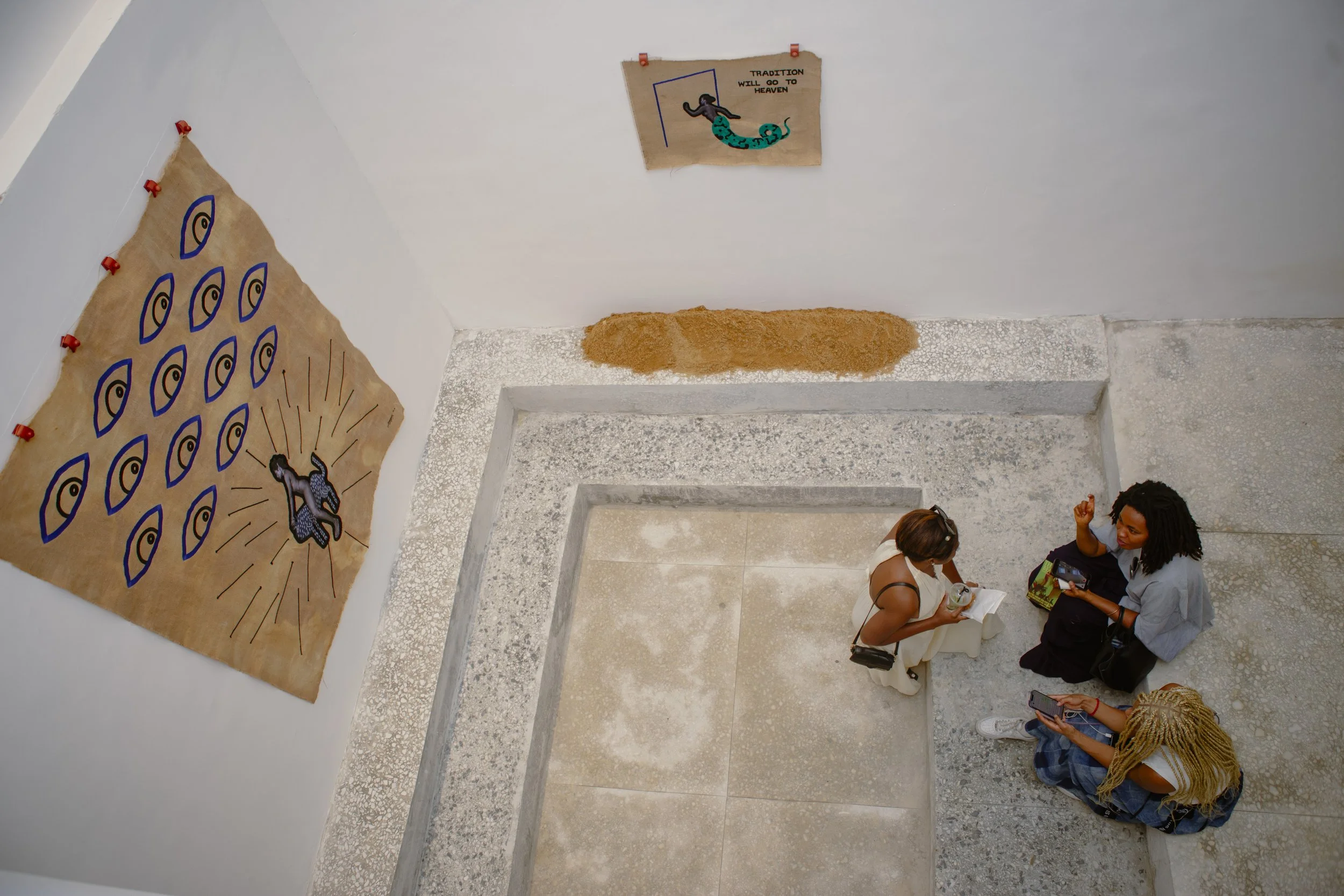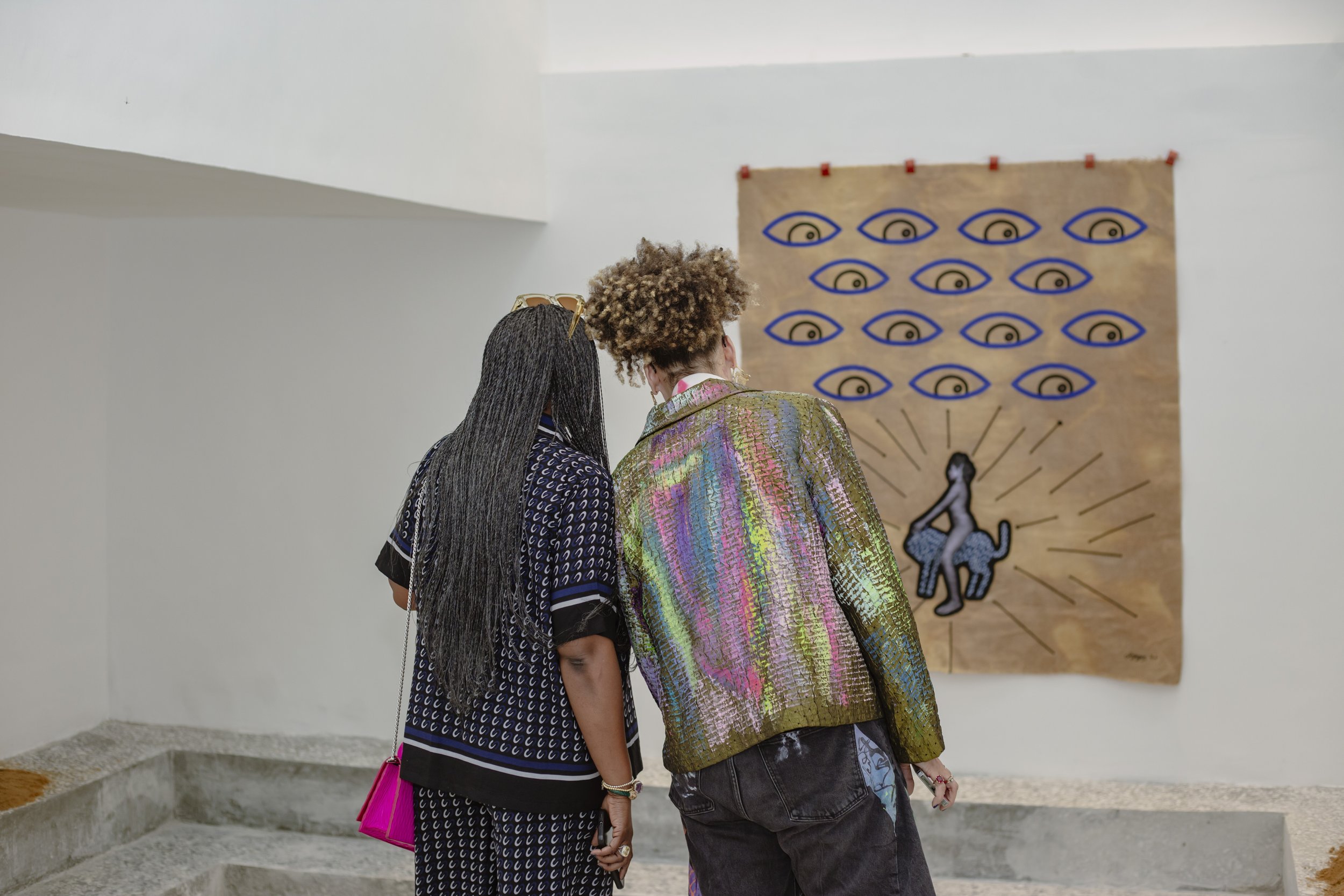Sahara Longe: Deceit, 2025 | Green and purple nude, 2025
interview by Lola Titilayo
photography by Adedamola
Sitting at the intersection of art, culture and fashion, Oyinkansola Dada is a multidimensional creative force. Trained as a lawyer but driven by a deep commitment to storytelling and cultural awareness, she has become one of the most dynamic connectors of artists across the African diaspora. As the founder of Dada Gallery, DADA Magazine, and the style-driven cultural phenomenon Lagos Is Burning, she has built a community that uplifts emerging voices while redefining how contemporary African creativity is seen and celebrated. With the recent opening of her first permanent gallery space in Lagos, Dada continues to shape the continent’s cultural landscape; promoting authenticity and creating spaces where African art and identity can thrive globally.
LOLA TITILAYO: You began your journey as a corporate lawyer in London and later made the bold decision to transition into the art world by opening a physical gallery space in Lagos. Can you walk us through that journey? What inspired you to take this leap?
OYINKANSOLA DADA: I just felt like it was the right time to do so, and for the past couple of years, I've been essentially experimenting, trying to figure out how to position myself within the art world. A lot of galleries open so quickly, and they shut down quite quickly as well, and I think that’s because they haven’t really given themselves ample time to figure out what type of programming they want to represent: what type of works they want to show, what kind of artists, what their voice is. For me, the seven years of balancing both careers has given me the opportunity to really figure out where I want us to be, and it happened at the perfect time. It was just a gut instinct to make this leap now.
Yagazie Emezi: Homecoming 2024
TITILAYO: You’ve spoken about using art as a way to build community and connect people around the world. What does “community” mean to you in the context of your gallery, especially operating between London and Lagos? And how do you see your role as a connector?
DADA: For me, it’s really about creating a space where people can come in and not just engage with art, but also engage with like-minded people. This will be reflected in the quality of programming we put on and in the types of shows that we do. We’re going to have a library in the space as well; it’s not a huge one, but it’s something that encourages people to stay. Even in the way we’ve built the gallery, we have a conversation pit that really encourages people to sit down and take a minute.
Combining all of this, I really want to create a sense of home when people come into the space, because we don’t have many third spaces in Nigeria, and it’s nice to have somewhere where you’re seeing thought-provoking art that makes you feel excited to be there.
We have the gallery, and we also have the art club; these are ways in which we engage this idea of community. With the art club, we’re going to keep doing different events across the world, not just in Lagos; it’ll also be in London and New York, activating different spaces. For me, it’s about connecting people who are interested in artists from the Black diaspora and people who are interested in new ideas.
Yagazie Emezi: Homecoming 2024
TITILAYO: Many galleries focus purely on commercial activity, but yours places a strong emphasis on African art and diasporic creative practices. How do you balance the commercial realities of running a gallery with the mission-driven side of elevating underrepresented artists and stories.
DADA: They’re not separate things. We still primarily show a lot of paintings and sculptures; we show a lot of art that you can sell, so there’s still commercial viability. A good gallery has a balance of that, but also has space for things that are more experimental, things you can’t quite make money from but that add to the gallery’s reputation and still bring people into the space. You might not necessarily make any money from it, but there are other ways to make money as well, which I think galleries should explore. There are ways of working with brands or different partners that don’t always rely on the individual collector. How do we look at art outside of the individual collector? How do we capture mass audiences?
TITILAYO: What were some of the key challenges you faced when opening a physical space in Lagos, and conversely, what advantages do you see for artists and collectors in Nigeria that are unique?
DADA: As with everything that has to do with Nigeria, there’s a lot of chasing, a lot of back and forth; doing business here is not always straightforward. At the same time, there’s a lot of opportunity because we can focus on nurturing talent and bringing high-quality art into the ecosystem. It’s about centering Lagos as a place for convergence and community, bringing international artists to Lagos, which I think is important, while also creating a platform where they can exchange ideas with people in the city. I think that creates a nice synergy, because the city is not only learning, but it’s taking and giving at the same time. Being able to create that is really special.
That’s also what informed our inaugural exhibition, which brings together artists from the Black diaspora, Brazil, Austria, the United Kingdom, and America. Bringing all these artists together, artists who otherwise might not have met or who have never even been to Lagos, there’s something really powerful about that. We’re really activating the city in that way.
Sahara Longe: Green and purple nude, 2025
TITILAYO: In July, DADA gallery collaborated with Gabriel Moses on his Saleh exhibition tour. Could you tell us how that project came about, what made it special, and how it reflects in your broader vision for art and culture?
DADA: So we did a tour with him that was called DADA. What we do with the club is, for artists that I like and that I know people are interested in, I reach out to them and ask them to host us. We create a space for people to not only meet each other but also to meet the artist. In terms of why I chose him for the art club, it was because Gabriel Moses is such an incredible artist, and he’s doing some of the most culturally relevant work. For such a young artist, the breadth of his work is huge, and I thought it would be great to have people experience that.
TITILAYO: Looking ahead, what are you most excited for and how do you see the gallery evolving in the coming years?
DADA: I’m most excited to just have the permanent physical space. It’s so powerful; there’s so much you can do. Although the pop-up model was freeing, it was also limiting at the same time. There’s nothing like having a place to call home, to continue doing your program, and to really contribute to the city. I’m very excited to host some incredible artists in Lagos and help nurture talent in the city as well. I’m also very excited about the kind of programming we can do; the vision is so broad that the sky is the limit for what we can do with the Lagos space. I’m very excited for new beginnings and the next chapter, ready to go headfirst and see what we can do.
TITILAYO: For emerging artists or creative entrepreneurs who might be debating a big pivot like the one you took; from a stable profession into the art-world risk, what advice would you give them? What mindset, habits, or strategies helped you navigate that transition successfully?
DADA: Take your time. I think it’s very important to be practical in terms of money and your plan. For me, because I was able to experiment and test out ideas while I had a stable full-time job, it really gave me a lot of data that I could use. Not everyone can do that, but if you can start while you’re still working, that’s very good because then you know what you’re getting into.
Being patient and actually committing the time, everything takes sacrifices. You have to be ready to do that and be patient with yourself as well. There were times when I was working and I just felt like I was doing nothing or felt like I wasn’t doing enough, but that’s part of the process, really. When it’s time, you’ll know, but you really need to not be afraid. Listen to yourself, really.
TITILAYO: To wrap up, who are some artists you’re currently excited about or inspired by?
DADA: There are some really incredible artists, both in Africa and outside of Africa, that we’re excited to work with. The artist for the opening exhibition, Sahara Longe, is an incredible painter I’ve been following for years, so we’re really honored to have her. Silvanah Mendes, Larissa de Souza, these are artists we’ve announced for the exhibition. We’re looking forward to discovering new talent, as well as working with already established artists.
Taylor Simmons. | Holding, 2023 | Patron, 2023 | Black man fashion, 2023.





